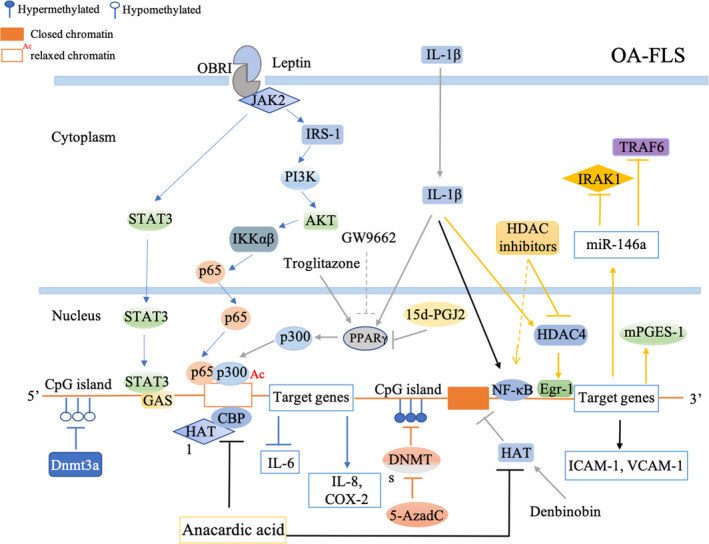FIGURE 2.

DNA methylation and histone acetylation involved in OA‐FLS inflammation. 5‐AzadC, a DNA methyltransferase inhibitor, up‐regulated miR‐146a by decreasing binding affinity between NF‐κB transcription factors and the hypermethylated miR‐146a regulatory regions. Dnmt3a, a DNA methyltransferase, increased the IL‐6 promoter methylation then suppressed IL‐6 production. Anacardic acid, a histone acetyltransferase inhibitor, decreased histone acetylation and binding of HAT1 and CBP on the IL‐6 promoter then suppressed IL‐6 expression. leptin promoted IL‐8 expression through the leptin receptor (OBRI), JAK2, STAT3 pathway as well as the initiation of IRSI, PI3K, Akt, NF‐κB‐dependent pathway and the following recruitment of p300. 15d‐PGJ2 inhibited IL‐1β‐induced COX‐2 production by suppressing H3 acetylation at the COX‐2 promoter through repressed HAT p300 recruitment. HDAC inhibitors (SAHA, LBH589) promoted the binding between the transcription factor NF‐κB and the miR‐146a promoter, subsequently increasing miR‐146a expression levels. Denbinobin increased miR‐146a expression, leading to a decreased monocyte adhesion by reducing the IL‐1β‐induced ICAM‐1, VCAM‐1 through regulated NF‐κB‐binding sites positioned within the miR‐146a promoter region. Anacardic acid attenuated denbinobin‐mediated increase in the HAT activity, histone H3 acetylation at both the NF‐κB‐binding sites and miR‐146a expression. HDAC4 promoted IL‐1‐induced mPGES‐1 production by up‐regulation of Egr‐1 transcriptional activity
